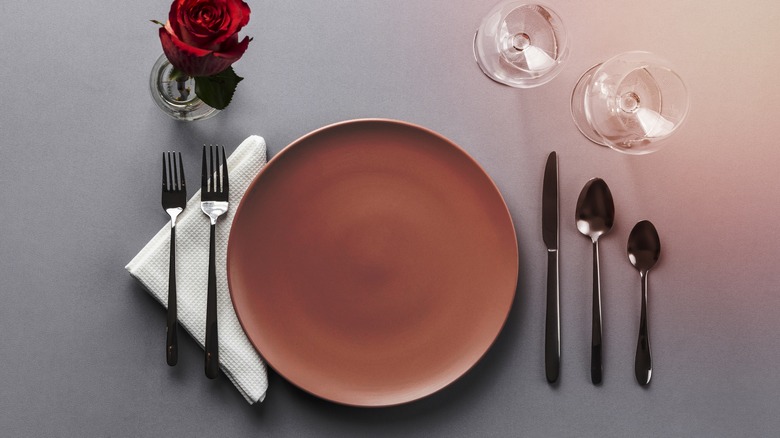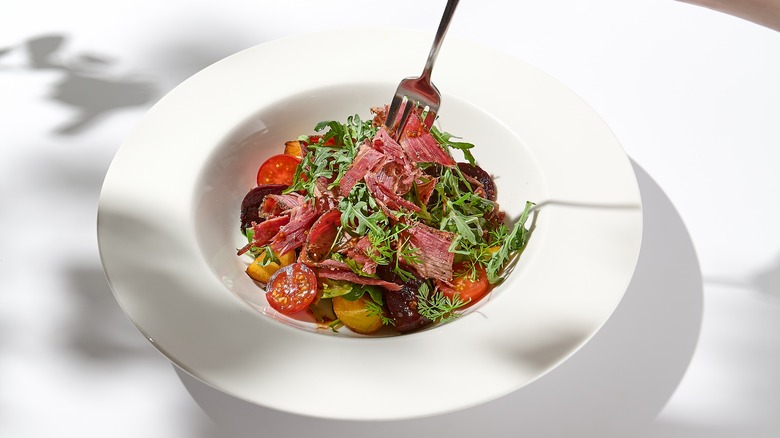The Subtle Differences Between A Salad Fork And A Dinner Fork
Have you ever been to a fancy dinner party and suddenly found yourself stumped by the array of utensils laid out before you? If so, we're here to demystify the subtle yet significant differences between a salad fork and a dinner fork. After all, to the untrained eye, a fork is simply a fork. But oh, how wrong that assumption can be.
The dinner fork, for instance, is a versatile utensil that can be used to enjoy anything from a juicy steak to a tender baked potato. With its four even tines of equal length and spacing, the dinner fork is the workhorse of the cutlery drawer. On the other hand, the salad fork is a delicately designed tool that is specifically crafted for, well, eating salads and other small bites.
Smaller in size and shorter in length, this fork has four tines, just like its counterpart. However, the main difference, according to Wine Enthusiast, is that the left tine is wider. You might also notice that the tips of the tines are slightly duller than a dinner fork, a design feature that makes it easier to break up pieces of lettuce without ripping them apart.
While these differences may seem minor, understanding the distinctions between them can elevate any dining experience. So, the next time you're staring down a set of forks, take notice: Which one will you choose? Here are a few tips to ensure you make the right choice.
How to identify a salad fork
When it comes to dining etiquette, there are a plethora of rules to follow, and one of the most sacred rituals is knowing which fork to use for which dish. And while it may seem trivial to some, the subtle differences between a salad fork and a dinner fork can make all the difference in how you enjoy your meal — salad forks, like pastry forks, are often designed to make it easier to cut into foods that don't require a knife.
How can you be sure which fork on the table is the salad fork, though? You just need to know where to look. According to Country Living, a salad fork can usually be found to the left of the dinner fork. If there are multiple utensils to the left, the salad fork will be the outermost one.
Size matters, too. A salad fork is typically shorter and smaller than a dinner fork, making it easier to maneuver through a bed of greens without disrupting other items on the plate. Additionally, the tines of a salad fork are generally wider and flatter than those of a dinner fork.
Lastly, depending on where you are in the world (American salad forks differ from their European counterparts), a salad fork may have a slightly curved bowl that can scoop up a dressing or any other liquid that may be served with your salad. The curve ensures that you get every last drop of dressing, leaving nothing to waste.
Do you use a salad fork differently?
Despite the subtle differences between a salad fork and a dinner fork, utensil etiquette remains relatively the same regardless of which type of fork you use. However, as Taste of Home points out, utensil etiquette differs between the U.S. and Europe.
In both regions, once you've taken your first bite, the fork stays in your dominant hand for the remainder of the meal. However, if you're looking to impress at a formal dinner party, it's worth noting that European dining etiquette is considered the gold standard.
And while there may be slight variations depending on the country, the general rule of thumb involves holding the fork in your left hand, tines pointed down, and the knife in your right hand, with the blade facing inwards. The fork is used to spear food and bring it to your mouth, while the knife serves to cut pieces smaller if necessary.
Whether you're in the U.S. or Europe, the salad fork will be used the same way as the dinner fork — with the left hand, or in the right hand after "cut and switch" in America. However, when it comes to fine-dining situations, it's always best to err on the side of caution and follow local etiquette.
Ultimately, mastering etiquette takes time and practice, and the best way to improve is by simply trying. So go ahead, pick up your salad fork with confidence, and savor every delicious bite.


